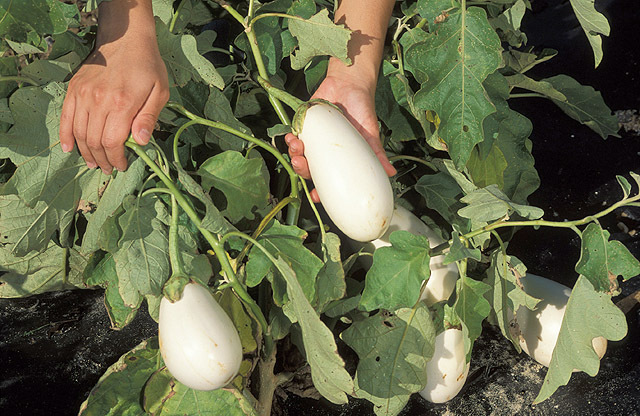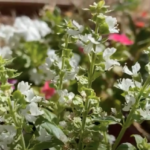Edible white eggplant is technically a fruit commonly known as a vegetable which is similar in all aspects, save for pigmentation, to the all familiar purple eggplant. The white eggplant comes in two species – edible and inedible. While the edible eggplant follows regular culinary applications, the inedible white eggplant is primarily used for ornamental purposes. These two types of eggplants have very close resemblance and can be cultivated in home gardens according to their different varieties.
Table of Contents
What is White Eggplant?
Depending on the region of the world, the eggplant is known by its diverse common names which are eggfruit, brinjal, aubergine, gilos, mad apple, guinea squash, tomato-fruited eggplant, and nasubi. According to the USDA AgMagazine, Thomas Jefferson is credited for introducing the eggplant to the United States. Furthermore, according to another source, the wild inedible white eggplant species was discovered in the 1800s by a French botanist named Michel Félix Dunal.
It is said that in the United States, southerners believe that the white aubergine is sweeter than the purple eggplant. Perhaps this is one reason the white cousin of the purple eggplant is a common feature here.
Edible White Aubergine
Edible white eggplant along with the purple eggplant, are domesticated eggplants botanically known as Solanum melongena belonging to the nightshade family. In this family are your everyday cooking ingredients such as potatoes, peppers and tomatoes. The white eggplant species has a number of varieties which include white beauty, casper and Japanese white egg (see varieties section).
Characteristically, the white eggplant is oblong in shape, white to creamy looking on the outside with a gentle tapering curve which starts from the calyx where it attaches to the stem. Even when ripe, the white brinjal maintains its life-long white peel pigmentation.
When cut open, the white eggplant reveals similarly white to creamy inner flesh held together by a thin outer skin. Depending on the stage of maturity, clearly visible in a pattern-like fashion, are seeds which tend to be more pronounced the older the eggplant gets. For this reason, some growers prefer to harvest immature white eggplants to avoid the conspicuous seeds when cooking.
Inedible White Aubergine
The inedible white eggplant is a different species of eggplant altogether, which is essentially wild. It is botanically identified as Solanum ovigerum, a separate kind of eggplant although of close resemblance to the Solanum melongena. The plant is cultivated and sold exclusively for ornamental purposes. It is pleasing to behold and is often referred to as the easter egg eggplant in some circles.
This eggplant fruit starts of white in its immature state before shifting to yellow when fully ripe. The plant structure is distinctly different from the edible species in that this inedible white eggplant is low-growing and has branches. Its stems are green so are the leaves with occasional purple on the stems and leaves in some cases. In addition, the plant produces lilac looking flowers. According to the University of Florida Extension, bigger fruits and dwarf plant types of this species have been reported.
Why are Eggplants White?
White eggplants are white because they lack anthocyanin pigments. The white due to a lack of anthocyanins is actually in the skin or peel off the eggplant. Anthocyanins are soluble compounds that give fruits and vegetables their color. In particular, anthocyanins give fruits, vegetables and flowers their red, purple or black pigment. For example, purple basil is rich in anthocyanins so are purple eggplants, purple lettuce, purple tomatoes, purple broccoli, purple grapes and berries.
Unlike the purple eggplant, white eggplant has no pigment to provide the same color as its peer. The purple skin of the purple eggplant provides it with an advantage over white brinjal in respect of health related benefits. Apparently, the purple color giving anthocyanins carry certain health benefits
White Eggplant Benefits
As earlier indicated, the main difference between purple and white eggplants is the skin color or peel. Internally, the two varieties look just about the same. The lack of anthocyanins in white eggplants denies the fruit some functional foods related benefits. By definition, functional foods offer more than just nutrition, but also superior health benefits such as anti-inflammatory and anti-cancer properties.
Although many have characterised white eggplants as bringing very little to the table in respect of nutrition, this variety can be counted upon for the high fibre. Furthermore, according to one source, eggplants, white or purple, have potassium, magnesium, folic acid, vitamin B6 and A to give. This indicates nutritional value of sorts.
Furthermore, the low calories, fat and sodium in eggplants also make them a regular feature in keto-friendly recipes. In addition, eggplants play an appreciated role in recipes of absorbing and storing flavors.
White Eggplant Varieties
Similar to purple eggplant which has different varieties, white eggplant also has its own varieties some of which we consider below. We find that the bulk of white eggplant varieties are heirloom kinds which suggests that much less work has gone into developing new varieties in hybrid form.
White Beauty Eggplant
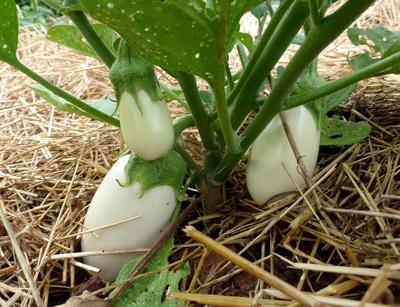
White beauty is an edible heirloom variety that performs well in hot and humid environments. The plant of this variety grows to 3 feet or 91cm tall. Fruit produced by the plant can be as wide as 6 inches or 6cm in diameter with an oval looking shape.
Casper White Eggplant
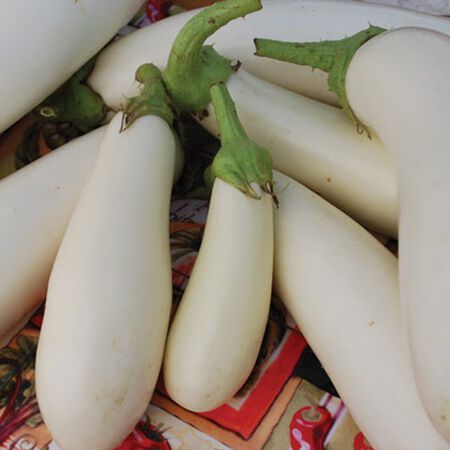
This is another heirloom variety which is perhaps better known than the other white varieties. It is a French heirloom producing a compact bush up to 3 inches or 7.6cm in height. Its fruits offer a mild taste and have white flesh. For recipe preparations, it goes well in soups, stews and roasts thanks to its mushroom-like flavor.
The skin of the eggplant is shiny with an ivory white hue from whence it gets its name after Casper the Friendly Ghost television animation character. Casper eggplant is also common because it can grow without any serious hindrances just about anywhere in the United States.
Japanese White Egg Eggplant
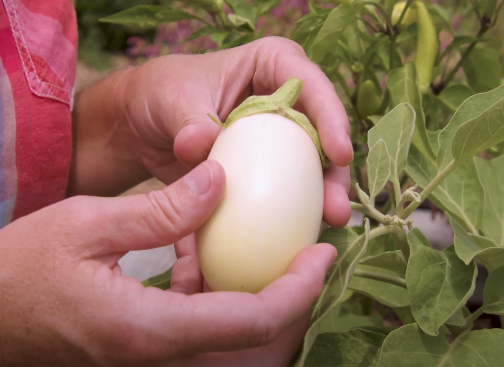
Care must be taken not to confuse this heirloom variety with the regular Japanese white eggplant. This is the Japanese white egg eggplant which specifically derives its name from its egg-like fruit which grows to the size and shape of an extra-large hen’s egg.
One of its main characteristics is its basically seedless interior. The flavor is subtle and mild with a creamy texture and can be used in stir-fries. It grows to about 3 feet or 7.6cm tall and is suitable for garden or pot planting. Found here is an interesting account of a regular gardener’s experience growing this variety.
Bride White Eggplant
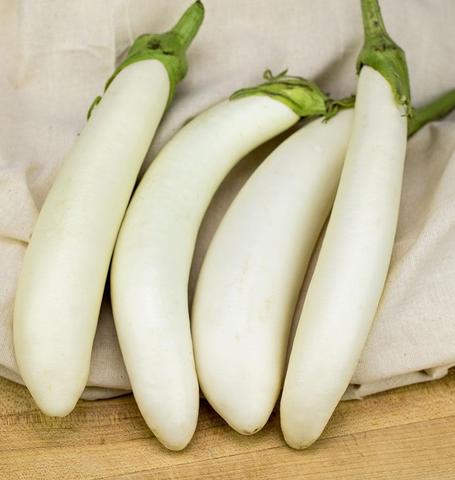
Bride white eggplant is a hybrid variety maturing in 58 days produced by West Coast Seeds in North America. The high yielding plant produces white slim looking fruit which can grow as long as 8 inches or 20cm. It has upright compact plants. During trials, Bride white eggplant performed better than other varieties, producing continuous tender fruit.
The variety is suitable for outdoor cultivation and was shown to be tolerant of bacterial wilt disease.
White Eggplant Recipes
If you are wondering what to do with white eggplants, there are probably as many recipes for white eggplants as there are for regular purple eggplants. This is the case because any recipe calling for purple eggplant will almost always achieve the same result using white eggplant. Below is our suggested list of scrumptious recipes using white aubergine.
| White Eggplant Salad Recipe – this recipe produces a creamy looking salad dish using a bunch of white aubergine. The recipe serves 2 and takes some 60 minutes to make. Other ingredients include strained yogurt, dill, lemon and garlic. The eggplants are grilled or baked with skin on first, before they are peeled and cut up into some cubes. The other ingredients are then added to finalise the recipe. View Recipe. |
Spicy White Eggplant Salad Recipe – this recipe calls for two white aubergines although purple ones can also be used as an alternative or even a mixture of both. Other ingredients are peppers, red and green, extra virgin oil, freshly ground black pepper, garlic, cider vinegar and golden raisins among other ingredient items. The eggplants are roasted for some 60 minutes until they are very soft and the skin is shrivelled. View Recipe. |
| Parmigiana Bianca Recipe – if you are looking for something Italian, this is an Italian recipe calling for 2 large eggplants. The recipe produces a hearty vegetable dish courtesy of the eggplants. Other ingredients on board include eggs, breadcrumbs, Parmesan or pecorino cheese and olive oil among others. As part of recipe steps, the eggplants are sliced up into small slices and fried in generous olive oil until golden brown and soft. View Recipe. |
| White Eggplant Lasagna Recipe – ever thought of making lasagna using eggplant? Well this recipe achieves exactly that. The recipe requires eggplants thinly sliced on mandolin (see below). The thinly sliced eggplants are put in a preheated oven for some 10 to 15 minutes to a point of having the edges slightly browned. Additional steps follow once the slices are ready. View Recipe. |
| Burundian Eggplant Sauce Recipe – this recipe has its roots in Burundi. It uses Japanese white egg eggplants along with olive oil, bell pepper, red or white onions and celery leaves among other ingredients. The eggplants are sautéed until golden. The final product out of this recipe will be a thick sauce that can be served with rice, cooked banana and baked sweet potatoes. View Recipe. |
| Italian Pickled Eggplant Recipe – this is yet another Italian recipe this time of pickled eggplants. It produces an Italian appetizer or side dish. White eggplant can be used in this recipe alongside other ingredients such as white vinegar, Italian parsley, garlic, hot pepper flakes and olive oil. The recipe takes 28 minutes to make and will require a resting time of one full day. View Recipe. |
| Thai White Eggplant Stir-Fry Recipe – finally, this recipe takes altogether 20 minutes to make. It requires 6 baby Thai white eggplants. In the absence of these, we suggest using Japanese white egg eggplants which are essentially petite eggplants.The recipe will have a spicy seasoning of ginger, green chilli (you could also use sweet pimentos), coriander and coconut powder. To soften the seeds in the baby eggplants, they will be sautéed in oil first before proceeding with using them. View Recipe. |
| Chicken and Eggplant Stew – this is a super simple recipe that combines eggplant and chicken into a delicious stew. This recipe gives you the leeway to use purple or white eggplant. Other ingredients involved include Worcestershire sauce, ground black pepper, and basil. The small eggplant used in this recipe is first cubed and fried together with garlic and onion for about 5 minutes. View Recipe. |
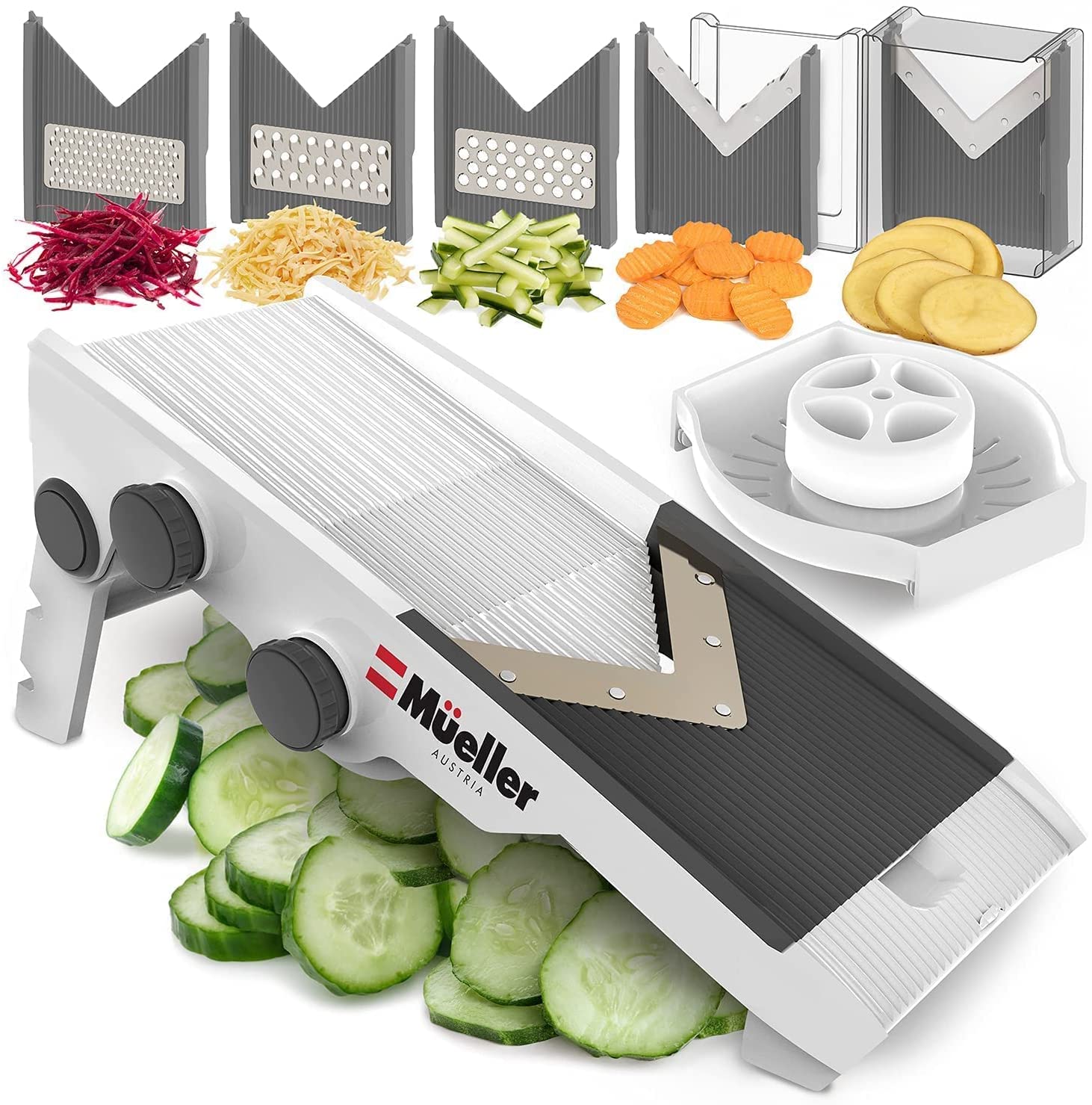 |
| Adjustable Eggplant Mandoline – we suggest this adjustable mandoline, which is ideal for thinly slicing eggplants for any recipe. For example, the white eggplant lasagna recipe listed above calls for thinly sliced slices. This is the device for the job which can also be used on other vegetables and fruits such as tomatoes, cucumber, carrots and apples. This mandoline slices just about all the vegetables used in the modern kitchen. It also has a handful of interchangeable blades which produce a variety of nice looking patterns on the sliced produce. See on Amazon. |
Growing White Eggplants
Growing white eggplants and taking care of white egg plants is very similar to the approach with purple cultivars. Being a warm weather crop, white eggplant can be propagated from seed indoors for later transplanting into the ground once frost has ended.
Furthermore, this egg plant variety is also well adapted to container culture. This means it can easily grow in containers on the balcony or patio. It is suggested to choose compact eggplant plant varieties if going with containers. Take care that the container ought to be large with very good drainage.
For in depth information on growing eggplants (which applies to both white and purple cultivars), we suggest this authoritative resource, Growing eggplant in home gardens, by University of Minnesota Extension.
White Eggplant Characteristics
The following is a summary of white aubergine characteristics.
| Item | Description |
| Botanical names | Solanum melongena (edible), Solanum ovigerum (inedible) |
| Common names | Eggfruit, brinjal, aubergine, gilos, mad apple, guinea squash, tomato-fruited eggplant, nasubi |
| Size | Varies with variety, can be small to medium size |
| Shape | Varies with variety, can be as oblong, curved, or ovular as hen’s egg |
| Color | White or creamy-white, orange-brown (for inedible) |
| Skin & Flesh | Thin skin, white, creamy-white skin |
| Texture | Creamy white inside |
| Flavor | Mushroom-like flavor (not all varieties) |
| Maturity | Up to 120 days if started from seed |
Conclusion
White eggplant comes in two species which are edible and inedible. Edible eggplant is similar to the regular purple eggplant variety save for the skin pigmentation. Furthermore, this similarity goes as far as culinary applications. White and purple eggplants can be used interchangably in a variety of recipe preparations. Inedible eggplant is solely used for ornamental purposes in gardens and pots, for example.
Random But Good Reads:
